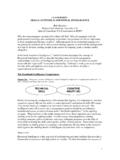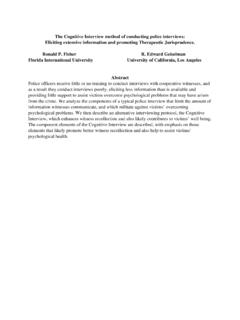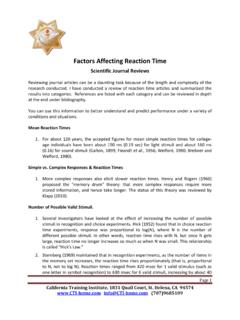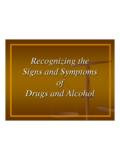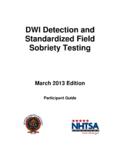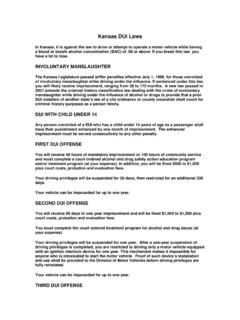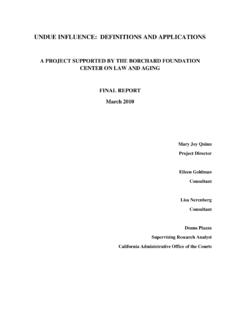Transcription of FATIGUE: WORKING UNDER THE INFLUENCE
1 Proceedings of the XXIst Annual International Occupational Ergonomics and Safety Conference Dallas, Texas, USA 11-12 June 2009 International Society of Occupational Ergonomics and Safety 317 ISBN # 97809652558-4-4 fatigue : WORKING UNDER THE INFLUENCE Sukwon Kim1, Ben D. Cranor1, and Young S. Ryu2 1 Department of Industrial Engineering and Technology Texas A&M University-Commerce Commerce, TX 75429 Corresponding author s e-mail: 2 Ingram School of Engineering Texas State University - San Marcos San Marcos, Texas 78666 Abstract: fatigue is a significant cause of accidents, harm, and hazard in all industries such as transportation (road, aviation, and rail), mining, manufacturing, construction, and healthcare. fatigue is a mental or physical description of how people feel in their daily life when they are tired or depressed.
2 This can be notice by observing or actions, when experiencing fatigue ; individuals usually have inability to continue functioning at the level of their normal abilities because of the lack of energy and motivation. fatigue can cause forgetfulness, a lost of remembrance or the ability to not think of something that will happen in a short or long term. Furthermore, fatigue can cost poor communication and lack of alertness. For example, a worker and a boss WORKING on a project and they are not in the same page or understanding each other; this can lead to confusion, contributing to larger disaster or loss to the company. Communication is very important and is a basic requirement for any daily activity and mostly universal and complex for all people in the world, but when people are feeling fatigue , it s hard to have a good communication.
3 The examples of accidents due to fatigues are the Chernobyl nuclear reactor meltdown (lack of action by shift workers), the Exxon Valdez oil spill (workers fatigue due to excessive workload), and the Waterfall train derailment in NSW (the train crew s inability to respond due to fatigue ). This paper reviews 1) factors that cause fatigue , and 2) signs and symptoms of fatigue and, in discussion, the paper attempts to communicate the impacts of fatigue at work as fatigue mimic alcohol intoxication. 1. FACTORS THAT CAUSE fatigue It is understood that fatigue is typically caused by physical, cognitive and emotional activities or by lack of sleep. Chemical causes such as poisoning can contribute to fatigue development, as well as can certain diseases (" fatigue (medical)," 2006).
4 Other causative factors of fatigue include inadequate recovery time from the expenditure of physical and mental effort, jetlag, stress, boredom, circadian disruption, mental challenge, monotony, etc. After reviewing numerous literatures, factors which can cause fatigue have been listed and described as below. Sleep Chronic Insomnia is the common cause of fatigue , and disturbed sleep is the most significant factor causing fatigue . Work load, female gender, and lack of exercise were the other significant factors (Akerstedt, et al., 2004). However, quantitative sleep characteristics such as sleep latency, nocturnal awakenings, and early morning arousals were not found to be significant causes of fatigue , while depression levels, somatization levels, and subjective sleep quality were more significant causes (Lavidor et al.)
5 , 2003). In the contrast, fatigue can be the cause of sleep disorder as well (Lichstein et al., 1997). Nutrition Literatures suggest a number of marginal nutritional deficiencies may cause chronic fatigue syndrome. These include deficiencies of B vitamins, vitamin C, magnesium, sodium, zinc, L-tryptophan, L-carnitine, coenzyme Q10, and essential fatty acids (Werbach, 2000). In addition, human body needs enough liquids throughout the day, but should avoid high Proceedings of the XXIst Annual International Occupational Ergonomics and Safety Conference Dallas, Texas, USA 11-12 June 2009 318 caffeine intake. Various drug intake can cause fatigue , especially the drugs effective on muscles (Landsberg, Vaughan, & Heffner, 1990). Age According to the study from the sample of ethnically diverse random community (Jason, et al.
6 , 1999), chronic fatigue syndrome was most prevalent among individuals in the age range of 40-49 years and least prevalent in 18- to 29-year olds and in those 60 years and older. However, it should be noted that older workers usually work fewer hours per week than the younger individuals. Disrupted Biological Clock The biological clock modulates hour-to-hour waking behavior, as reflected in fatigue and alertness, which generates circadian rhythmicity in neurobehavioral variables (Van Dongen & Dinges, 2000). Many factors can disrupt circadian rhythm. Those factors include motivational factors (Minors & Waterhouse, 1983), stress (Orr, Hoffman, & Hegge, 1976), food intake (Paz & Berry, 1997), posture (Kr uchi, Cajochen, & Wirz-Justice, 1997), ambient temperature and boredom (Mavjee & Horne, 1994), background noise (Landstrom, Lindblom-H ggqvist, & Lofstedt, 1988), and lighting conditions (Leproult, Van Reeth, Byrne, Sturis, & Van Cauter, 1997).
7 Physical Activity It is known that overtime work may be associated with chronic fatigue and then decrease cardiovascular function (Spurgeon, Harrington, & Cooper, 1997). Park, Kim, Chung, & Hisanaga (2001) found positive relationship between long WORKING hours and subjective fatigue complaints. Wu, Hsu, and Chen (2005) examined the effect of high intensity physical work on fatigue and recovery. The findings indicated that in high intensity work, physiological recovery time was significantly longer than subjective recovery time. Lack of physical activity also can cause fatigue . Inactivity induces muscular wasting and loss of cardiorespiratory function, which easily contributes to fatigue (Dimeo, 2001). Work Schedules and fatigue It has been shown that there are significant differences in fatigue between day and shift workers, so that shift workers prefer to transfer to day work (Jansen, van Amelsvoort, Kristensen, van den Brandt, & Kant, 2003).
8 The nature of the shift work may disrupt sleeping pattern and schedule that contribute to the perceived fatigue level (Ahsberg, Kecklund, Akerstedt, & Francesco, 2000). Monotony Monotony can be a causal factor of fatigue due to low arousal, boredom, and possibly due to stress. Monotony and fatigue are usually mentioned together for driving behavior studies. Often times fatigue and monotony are used as synonyms, because they both reduce driver s attention (Brandt, Stemmer, & Rakotonirainy, 2004), although they are different terms from psychological and medical point of view. Thiffault and Bergeron (2003) showed that disruption of monotony have positive effect on alleviating fatigue during tasks requiring driving. 2. SIGNS AND SYMPTOMS OF fatigue About 20% of Americans claim to have fatigue intense enough to interfere with their having a normal life.
9 Physical causes are estimated at 20-60%, and emotional causes are the other 40-80% ( ). The most common signs of fatigue are forgetfulness, poor communication, yawning, always tired, nodding off, lack of alertness, drowsiness, micro sleep, feeling withdrawn, feeling Proceedings of the XXIst Annual International Occupational Ergonomics and Safety Conference Dallas, Texas, USA 11-12 June 2009 319 moody, feeling quick to anger, feeling irritable, no sense of humor, slow reaction time, boredom, depressed, lack of interest, restlessness, tired or sore eyes, and impaired decision making skills. Forgetfulness Forgetfulness is the lost of remembrance or the ability to not think of something that happens in a short or long term. It s a sign of fatigue , because forgetting can be from stress, lack of rest or even sleep.
10 Poor Communication fatigue can cause poor communication. A research has shown that children who passively exposed to TV (22,000 hours between the ages of 3 & 18 today) exhibit a greater % of slower brain wave activity which is also related to such factors as fatigue , drugs, & poor communication (Gambion and Richard, 1972). Yawning According to , yawning is a normal response to fatigue and drowsiness, but excessive yawning can be caused by a vasovagal reaction. This reaction is cause by the action of a nerve, called the vagus nerve, on the blood vessels (Shikdar et al, 2003). A review of the literature reveals that yawning is a sign of fatigue that brain stem arousal reflex with both peripheral and central loops subserving reversal of brain hypoxia or hypoxemia (Shikdar et al.)
